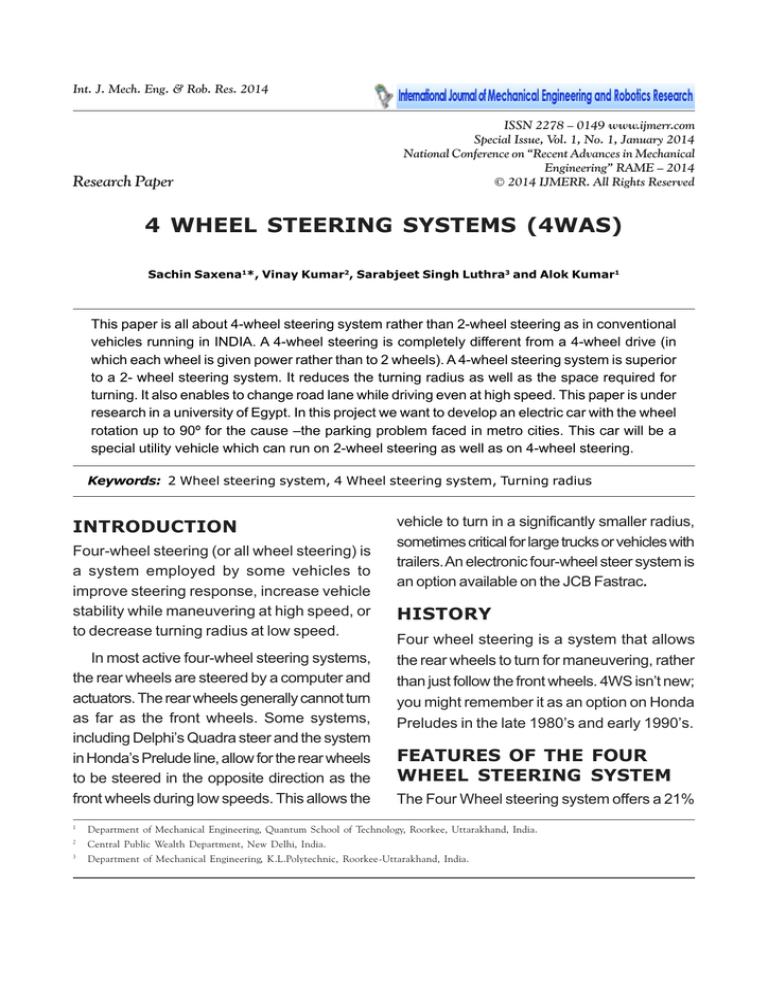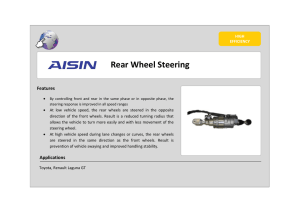
Int. J. Mech. Eng. & Rob. Res. 2014
Sachin Saxena et al., 2014
ISSN 2278 – 0149 www.ijmerr.com
Special Issue, Vol. 1, No. 1, January 2014
National Conference on “Recent Advances in Mechanical
Engineering” RAME – 2014
© 2014 IJMERR. All Rights Reserved
Research Paper
4 WHEEL STEERING SYSTEMS (4WAS)
Sachin Saxena1*, Vinay Kumar2, Sarabjeet Singh Luthra3 and Alok Kumar1
This paper is all about 4-wheel steering system rather than 2-wheel steering as in conventional
vehicles running in INDIA. A 4-wheel steering is completely different from a 4-wheel drive (in
which each wheel is given power rather than to 2 wheels). A 4-wheel steering system is superior
to a 2- wheel steering system. It reduces the turning radius as well as the space required for
turning. It also enables to change road lane while driving even at high speed. This paper is under
research in a university of Egypt. In this project we want to develop an electric car with the wheel
rotation up to 90º for the cause –the parking problem faced in metro cities. This car will be a
special utility vehicle which can run on 2-wheel steering as well as on 4-wheel steering.
Keywords: 2 Wheel steering system, 4 Wheel steering system, Turning radius
INTRODUCTION
vehicle to turn in a significantly smaller radius,
sometimes critical for large trucks or vehicles with
trailers. An electronic four-wheel steer system is
an option available on the JCB Fastrac.
Four-wheel steering (or all wheel steering) is
a system employed by some vehicles to
improve steering response, increase vehicle
stability while maneuvering at high speed, or
to decrease turning radius at low speed.
HISTORY
Four wheel steering is a system that allows
the rear wheels to turn for maneuvering, rather
than just follow the front wheels. 4WS isn’t new;
you might remember it as an option on Honda
Preludes in the late 1980’s and early 1990’s.
In most active four-wheel steering systems,
the rear wheels are steered by a computer and
actuators. The rear wheels generally cannot turn
as far as the front wheels. Some systems,
including Delphi’s Quadra steer and the system
in Honda’s Prelude line, allow for the rear wheels
to be steered in the opposite direction as the
front wheels during low speeds. This allows the
FEATURES OF THE FOUR
WHEEL STEERING SYSTEM
The Four Wheel steering system offers a 21%
1
Department of Mechanical Engineering, Quantum School of Technology, Roorkee, Uttarakhand, India.
2
Central Public Wealth Department, New Delhi, India.
3
Department of Mechanical Engineering, K.L.Polytechnic, Roorkee-Uttarakhand, India.
213
Int. J. Mech. Eng. & Rob. Res. 2014
Sachin Saxena et al., 2014
reduction in turning radius. So if a vehicle is
capable of making a U-turn in a 25-foot space.
It allows the driver to do it in about 20 feet. A
front wheel active steering function was added
to Rear Active Steer adopted on the Fuga. By
controlling the steering angle of all four wheels,
this active steering system helps improve
stability and response at high speed and helps
reduce driver’s steering workload at low
speed. To achieve precise vehicle
Medium speed
(40 km/h to 80 km/h)
Driving in urban areas
and on major roads
Vehicle moves stably in
the desired direction
and turning is smooth,
as the front wheels move
with less steering wheel
motion, and the back
wheels turn in the same
direction
• Vehicles move smoothly and are easy to
drive both in the city and on winding roads.
High speed
•
(over 80 km/h) Expressways, etc.
Added stability means vehicles can be
driven safely on expressways and when
changing lanes.
As the speed of the vehicle increases, the
turning angle of the front
wheels decreases, and
the back wheels turn in
the same direction as
the front, enabling the
vehicle to be driven stably
even when changing
lanes.
• Quick and responsive control system will
allow gentle steering operation.
Low speed
AVOIDING AN OBSTACLE
DURING EXPRESSWAY
DRIVING
(10 km/h to 40 km/h)
Turning in residential and parking
areas
Turning is easier, as
the front wheels
move with less
steering wheel motion.
At high speeds, the four wheel steering
system avoids skidding in cars taking higher
n sharper turns using ABS system. And at slow
speeds, the four wheel steering system helps
in reducing v turning radius by 21% which has
its applications in parking etc.
For parking and low-speed maneuvers, the
rear Wheel steer in the opposite direction of
the front wheels, allowing much sharper turns.
At higher speeds, the rear wheels steer in the
same direction as the front wheels. The result
214
Int. J. Mech. Eng. & Rob. Res. 2014
Sachin Saxena et al., 2014
The 2002 Sierra Denali’s turning radius is
almost 10 feet smaller than the 2001 Sierra
C3.
is more stability and less body lean during fast
lane changes and turns because the front
wheels don’t have to drag non-steering rear
wheels onto the path.
RECENT APPLICATION
The mechanism due to which the rear
wheels turn one way at low speeds and another
direction at high speeds can be controlled
electronically or hydraulically too. The
Japanese automakers have come up with an
astonishing variety of technological solutions.
Example: Mazda’s 626 four-door sedan turns
its rear wheels electronically. Sensors monitor
Four-wheel steering found its most
widespread use in monster trucks, where
maneuverability in small arenas is critical, and
it is also popular in large farm vehicles and
trucks.
General Motors offers Delphi’s Quadra
steer in their consumer Silverado/Sierra and
Suburban/Yukon. However, only 16,500
vehicles have been sold with this system since
its introduction in 2002 through 2004. Due to
this low demand, GM will not offer the
technology on the 2007 update to these
vehicles.
the car’s speed and its front-wheel angle and
pass the information to an onboard computer,
which determines in what direction the back
wheels should turn. At speeds less than 22
mph, the rear wheels counter steer; at more
than 22 mph, their turn version is simpler but
more limited. On its four-wheel steer, some
models, now available in Japan, the rear
wheels are incapable of counter steering, but
they can turn with the front wheels in the same
direction as the front wheels. Mitsubishi’s
Galant at high speeds, the action is controlled
hydraulically. The higher the oil pressure, the
more sharply the rear wheels turn.
Previously, Honda had four-wheel steering
as an option in their 1987-2000 Prelude, and
Mazda also offered four-wheel steering on the
626 and MX6 in 1988.
A new “Active Drive” system is introduced
on the 2008 version of the Renault Laguna line.
It was designed as one of several measures
to increase security and stability. The Active
Drive should lower the effects of under steer
and decrease the chances of spinning by
diverting part of the G-forces generated in a
turn from the front to the rear tires. At low
speeds the turning circle can be tightened so
parking and maneuvering is easier.
PRODUCTION CARS WITH
ACTIVE FOUR WHEEL
STEERING
215
Int. J. Mech. Eng. & Rob. Res. 2014
Sachin Saxena et al., 2014
Exhibit
•
•
•
•
•
•
•
•
•
•
•
•
BMW 850CSi (optional)
Efini MS-9 (high and low speed)
GMC Sierra (2002) (high and low speed)
Honda Prelude (high and low speed, fully
mechanical from 1987 to 1993)
Honda Accord (1991) (high and low speed,
mechanical)
Infiniti G35 Sedan (option on Sport models)
(2007-Present) (high speed only?)
Infiniti G35 Coupe (option on Sport models)
(2006-Present) (high speed only) [2]
Infiniti J30t (touring package) (1993-1994)
Infiniti M35 (option on Sport models)
(2006-Present) (high speed only?)
Infiniti M45 (option on Sport models)
(2006-Present) (high speed only?)
Infiniti Q45t (1989-1994) (high speed only?)
•
•
•
•
•
•
•
•
•
•
•
•
•
NEW ACTIVE DRIVE WITH
FOUR-WHEEL STEERING FOR
NEW RENAULT LAGUNA GT
AT GENEVA MOTOR SHOW
Mitsubishi Galant/Sigma (high speed only)
Mitsubishi GTO (also sold as the Mitsubishi
3000GT and the Dodge Stealth) (high speed only)
Nissan Cefiro (A31) (high speed only)
Nissan 240SX/Silvia (option on SE models)
(high speed only)
Nissan 300ZX (all Twin-Turbo Z32 models)
(high speed only)
Nissan Laurel (later versions) (high speed only)
Nissan Fuga/Infiniti M (high speed only)
Nissan Silvia (option on all S13 models) (high
speed only)
Nissan Skyline GTS, GTS-R, GTS-X (1986) (high
speed only)
Mazda 626 (1988) (high and low speed)
Nissan Skyline GT-R (high and low speed)
Renault Laguna (only in GT version of 3rd
generation which was launched October 2007, GT
launched on April 2008)
Subaru SVX JDM (1991-1996) (Japanese version:
“L-CDX” only) (high speed only)
Toyota Aristo (1997) (high and low speed?)
Toyota Camry JDM 1991 Camry Prominent 2.0
L V6[citation needed]
Toyota Celica (option on 5th and 6th generation,
1990-1993 ST183 and 1994-1997 ST203) (Dualmode, high and low speed)
• Prices start from £21,050 for the Hatch and
£22,000 for Sport Tourer
• New versions feature numerous sport styling
touches, including: lateral air-intakes and
larger front grille, new 18-inch alloy wheels,
smoked rear light clusters and black
background to the headlamps
• New high-performance GT versions of New
Laguna Hatch and Sport Tourer available
to order in the UK from 9 May 2008
• Inside, the new models boast GTembossed leather/alcantara sports seats,
drilled aluminium pedals, aluminium gear
knob and GT steering wheel
• Featuring innovative Active Drive chassis
with four-wheel steering for the ultimate in
handling and response
• Exclusively available with 205hp two-litre
turbo petrol engine or 180hp two-litre turbo
diesel – both making their debut in New
Laguna
DISADVANTAGES OF 4WS
VEHICLES
1. Significantly increase in work load for front
tyres.
216
Int. J. Mech. Eng. & Rob. Res. 2014
Sachin Saxena et al., 2014
2. Large amount of left/right weight transfer
seen in 4ws vehicle.
3. Uneven tyres wear of front and rear wheels.
The steering linkage transmits motion from
the steering gear to the wheels and regulates
the relative positions of the wheels.
Geometrically Correct Steering
ADVANTAGE
a the wheelbase, b the distance between the
Steering pivot axes
1. Computer-controlled Quadra steer can be
switched on and off and has an effective
trailer towing mode.
Cot θ – Cot Φ = b/a
2. A computer determines how much and in
which direction the rear wheels should
move, and whether the rear wheels should
turn the same direction as the front wheels
or in the opposite direction. The movement
is variable up to a couple of inches.
Γ = | θcorr – θactual |
3. At slow speeds, the rear wheels move the
opposite direction of the front wheels. This
makes for easier parking and maneuvering.
4. At highway speeds, the rear wheels move
in the same direction as the front wheels
for easier lane changing. If you’re pulling a
trailer you’ll really appreciate this feature,
since it allows your vehicle to change lanes
without the snaking-effect you’d normally
experience.
Four Wheel Steering Arrangement
Steering input is fed into the system through
the steering wheel.
Steering gear multiplies the steering effort
applied to the steering wheel by the driver. It
also converts the turning motion of the steering
wheel into a linear motion.
5. In order to accommodate the steering
mechanism and wheel movement, the
Sierra Denali’s track and fender width are
wider than its conventional counterpart, but
it’s not as wide as the rear of a dually pickup.
REFERENCES
1. Abdelhady M B (2007), “Enhanced
Vehicle Lateral Stability in Crosswind by
Limited State Kalman Filter Four Wheel
Steering System”, Document Number:
2007-01-0841, Date Published: April
2007.
217
Int. J. Mech. Eng. & Rob. Res. 2014
Sachin Saxena et al., 2014
Issue 6 (November 2005), Received 4
April 2005, in final form 8 June 2005,
Published 8 August 2005.
2. Alter David Law (1989), “Alex. Transient
Steady State Performance Comparison
of Two-Wheel Steering and Four-Wheel
Steering Vehicles”, Quadra steer 2.0.
Mazda Tetra COM.
9. Masao Nagai (1991), “Stability of 4ws
Vehicle Based on Side Slip Zeroing
Control: Influence of Steering System
Dynamics”, Document Number: 912564,
Date Published: November 1991.
3. At Geneva Motor Show, “New Active
Drive with Four-Wheel Steering for New
Renault Laguna GT”, 12:45 PM on Fri
Feb. 22, 2008
10. Three dimensional modeling and
dynamic analysis of four-wheel-steering
vehicles”, Journal Acta Mechenica
Sinica, Publisher: Springer Berlin /
Heidelberg, Issue, pp. 79-88, Vol. 19, No.
1, February 2003.
4. Brabec P, Maly M and Vozenílek R
(2004), “Control system of Vehicle model
with four wheel steering (4WS)”, An
International Journal, 04. 06.10.2004.
5. Gene Liao Y and Isaac Du H (2003),
“Modeling and analysis of electric power
steering system and its effect on vehicle
dynamic behavior”, International Journal
of Vehicle Autonomous Systems, Vol. 1,
No. 2/2003, pp. 153-166.
7. http://www.pickuptruck.com/html/stories/
qs420/page1.html
11. Wellstead P E and Pettit N B O L (19942006), “Analysis and redesign of an
antilock brake system controller”, Journal
Title-IEE proceedings. Control theory
and applications ISSN 1350-2379,
Institution of Electrical Engineers, Steven
age, ROYAUME-UNI (1994-2006)
(Revue).
8. Mark Denny (2005), “The dynamics of
antilock brake systems”, Print publication:
12. www.engr.uvic.ca/~forum/2004/abstracts/
David%20Cruz%20Dec%202004.pdf
6. http://mazda.tetracom.net/4ws.htm
218




